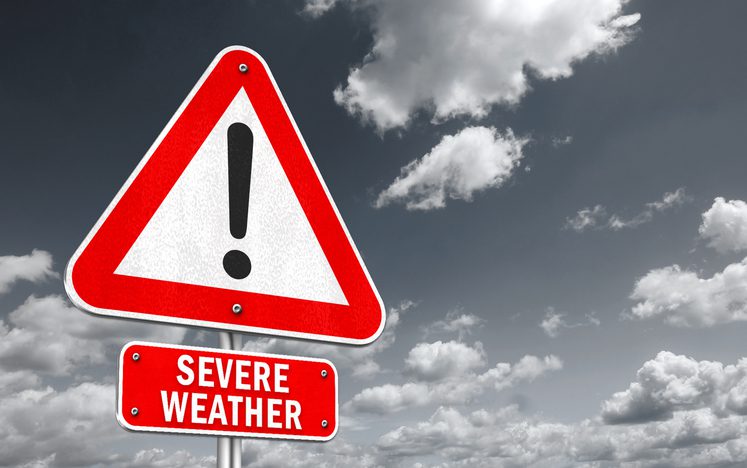If you live in an area that is prone to tornadoes, you are likely familiar with the preparations necessary to ready yourself for a tornado and the safeguards to follow during a storm. But if your home or community is damaged by a tornado, you’ll also need to know what to do once the storm has passed.
Learn more at The Hartford’s Catastrophe Information Center.
The tornado itself may cause severe damage to individuals and property, but the danger does not end when the storm does. In fact, a study in Marion, Illinois found that 50 percent of the injuries related to a tornado happened after the storm. Those injuries occurred during rescue attempts, cleanup efforts and other post-tornado activities. They included injuries from falling objects, rolling objects, stepping on nails, and fires, explosions, or electrocutions related to damaged power lines, gas lines or electrical systems. Here’s what you need to know to avoid damage and injury after a tornado.
Stay Safe
Taking cover during a tornado is essential—but just because you no longer hear the storm raging doesn’t mean you should emerge from your shelter. Instead, stay in your sheltered area and listen to your radio or television for official confirmation from local public safety personnel that it is safe to exit. Wait until you receive confirmation that the storm has passed and no further damage or destruction is expected to occur before you go out.
Once it is safe to leave, be very careful walking through damaged areas. Make sure to wear sturdy shoes and long clothing. Do not attempt to clean up debris, as broken glass, exposed nails and electrical wires, downed power lines, collapsed structures, and flooding could all present threats. Instead, focus on getting everyone out of the damaged area and to a safe place. Contact emergency workers to report the damage and find out whether help is available, such as food and supplies from the American Red Cross or other relief organizations.
Continue to listen to emergency broadcasts and local reports for the next 12 hours to receive updates and make sure the storm is officially over. If your home is without electricity, turn off most of the light switches and unplug appliances and electronics, such as microwaves and printers, to avoid overloading the circuits when the power is restored. Leave one light switch on so that you’ll know when the power is back on. To minimize the risk of fire, use flashlights rather than candles to light your home.
Never use devices powered by gasoline, propane, natural gas or charcoal (such as generators, camp stoves, grills, or pressure washers) inside your home, basement, garage, or camper. These devices release carbon monoxide (CO), which has no odor or color but can cause illness and death when inhaled. The CO can build up inside your walls and poison the people and animals inside.
Keep your refrigerator and freezer doors closed as much as possible to maintain the cold temperatures and keep food from warming. If you have medications that must be refrigerated, take them out and transfer them to a cooler with ice, ice packs, or frozen water bottles.
If the power remains out for more than six hours, you will need to throw out any dairy, eggs and raw meat. And don’t drink or use the water from your faucet until you have received confirmation that it has not been contaminated by storm damage. If you do need to drink or use the water from the tap, boil it before drinking or using it.
Check for Injuries
If others around you have suffered injuries as a result of the tornado, do your best to help them. Never try to move a seriously injured person unless they are in immediate danger of further injury.
If someone is bleeding, apply direct pressure to the wound to stop the bleeding. If someone is not breathing, attempt CPR if you have been trained to do so. Clean minor cuts with soap and clean water, and contact a doctor to find out whether the person needs additional treatment—for instance, a tetanus shot. If you or others near you have become trapped under debris, try to attract attention to your location. Call for help if your cell phone or landline is working.
Inspect the Damage
Once the weather has returned to normal and all injured individuals have been cared for, begin documenting what has happened on your property. Include any damage to your home, car, possessions, fencing, landscaping, or any other property. Take photos so that you have a visual record of the damage.
If the structure of your home is damaged, be very careful if you choose to enter it. It’s a good idea to shut off your electricity, natural gas, and propane tanks if you suspect damage to your home, to avoid potential electrocutions, explosions, or fires.
If you smell gas or think there may be a gas leak, turn off the main gas valve and leave the property immediately. Call the gas company, the local fire department, or the state fire marshal’s office, and do not turn on lights, light a match, or do anything that could create a spark.
If you do enter a damaged structure, wear sturdy shoes, gloves, and long pants and sleeves when walking on and around debris. Watch for broken glass and exposed nails, and never touch downed power lines or anything that is touching downed power lines. If you believe there are electrical hazards in or around your property, report them to the utility company.
In addition to your home, you should also inspect your vehicle for any possible damage. Your car may have been damaged by falling objects such as tree branches or been thrown by the wind.
If you have a smartphone, consider using an app like Disaster Recovery Log to take photos and save them alongside your own voice recordings describing the damage to your property. Once you’ve completed the inspection of your property, the app allows you to compress and save all your documentation in an Excel file for easy transfer.
Report a Claim If Needed
If you need to report a claim, contact your insurer right away. Your homeowners insurance will help pay for damages to your home and the comprehensive portion of your auto insurance will help pay for damages to your vehicle. Customers of The Hartford can file a claim by calling 1-800-243-5860 or visiting our online claims center.
When you contact your insurance company, a customer service representative will likely ask you to explain what happened, describe the damage to your property, and confirm your contact information. If you’re insured by The Hartford, a claims professional will contact you within one business day to assess the situation, discuss your options, and answer any questions.
If you live in an area prone to tornadoes, remember the storm itself is not the only danger you may face. After a tornado has subsided, it’s important to continue to take the proper steps to avoid additional injuries or damage, and to start the process of repairing or replacing your property.






